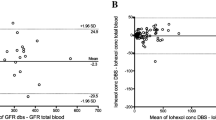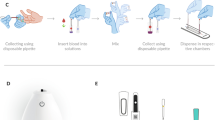Abstract
The use of portable chemistry analyzers is an attractive option for obtaining clinical pathology panels in mice, because these analyzers require only small volumes of whole blood. However, in studies with other animals, portable analyzers do not always agree with results obtained using standard laboratory equipment. The authors evaluated the use of the i-STAT handheld portable clinical analyzer compared to the use of standard nonportable laboratory instruments in mice. As shown with other species, the i-STAT results did not always agree with standard laboratory instruments; however, the i-STAT does show reliability for certain chemistry assays.
This is a preview of subscription content, access via your institution
Access options
Subscribe to this journal
We are sorry, but there is no personal subscription option available for your country.
Buy this article
- Purchase on Springer Link
- Instant access to full article PDF
Prices may be subject to local taxes which are calculated during checkout


Similar content being viewed by others
References
Jacoby, R.O., Fox, J.G. & Davisson, M.T. in Laboratory Animal Medicine (eds. Fox, J.G., Anderson, L.C., Loew, F.M. & Quimby, F.W.) 35–120 (Academic Press, New York, 2002).
Diehl, K.H. et al. A good practice guide to the administration of substances and removal of blood, including routes and volumes. J. Appl. Toxicol. 21(1), 15–23 (2001).
Anonymous. Removal of blood from laboratory mammals and birds. First report of the BVA/FRAME/RSPCA/UFAW Joint Working Group on Refinement. Lab. Anim. 27(1), 1–22 (1993).
Hoff, J. Methods of blood collection in the mouse. Lab Anim. (NY) 29(10), 47–53 (2000).
Erickson, K.A. & Wilding, P. Evalution of a novel point-of-care system, the i-Stat Portable Clinical Analyzer. Clin. Chem. 39(2), 283–287 (1993).
Jacobs, E. Vadasdi, E., Sarkozi, L. & Colman, N. Analytical evaluation of i-Stat Portable Clinical Analyzer and use by nonlaboratory health-care professionals. Clin. Chem. 39(6), 1069–1074 (1993).
Kisner, H.J. i-Stat point-of-care blood analyzing system. Clin. Lab. Manage. Rev. 7(5), 454–457 (1993).
Sediame, S., Zerah-Lancner, F., d'Ortho, M.P., Adnot, S. & Harf, A. Accuracy of the I-Stat bedside blood gas analyzer. Eur. Respir. J. 14(1), 214–217 (1999).
Cohn, L.A., McCaw, D.L., Tate, D.J. & Johnson, J.C. Assessment of five portable blood glucose meters, a point-of-care analyzer, and color test strips for measuring blood glucose concentration in dogs. J. Am. Vet. Med. Assoc. 216(2), 198–202 (2000).
Grosenbaugh, D.A., Gadawski, J.E. & Muir, W.W. Evaluation of a portable clinical analyzer in a veterinary hospital setting. J. Am. Vet. Med. Assoc. 213(5), 691–694 (1998).
Larsen, R.S., Haulena, M., Grindem, C.B. & Gulland, F.M. Blood values of juvenile northern elephant seals (Mirounga angustirostris) obtained using a portable clinical analyzer. Vet. Clin. Pathol. 31(3), 106–110 (2002).
Looney, A.L., Ludders, J., Erb, H.N., Gleed, R. & Moon, P. Use of a handheld device for analysis of blood electrolyte concentrations and blood gas partial pressures in dogs and horses. J. Am. Vet. Med. Assoc. 213(4), 526–530 (1998).
Verwaerde, P., Malet, C., Lagente, M., de la Farge, F. & Braun, J.P. The accuracy of the i-Stat Portable Analyser for measuring blood gases and pH in whole-blood samples from dogs. Res. Vet. Sci. 43(1), 71–75 (2002).
Bland, J.M. & Altman, D.G. Statistical methods for assessing agreement between two methods of clinical measurement. Lancet 1(8476), 307–310 (1986).
Gray, T.E., Pratt, M.C. & Cusick, P.K. Determination of agreement between laboratory instruments. Contemp. Top. Lab. Anim. Sci. 38(2), 56–59 (1999).
Pinckard, J.K., Zahn, J., Ashby, L., Parvin, C.A. & Scott, M.G. Falsely increased i-Stat chloride results for blood samples with increased urea. Clin. Chem. 47(11), 2064–2066 (2001).
National Committee for Laboratory Standards. Procedures for the Handling and Processing of Blood Specimens: Approved Guideline 3rd edn. (Clinical and Laboratory Standards Institute, Wayne, PA, 2004).
Acknowledgements
The authors thank Helen Jackson and the staff of the Section of Veterinary Laboratory Medicine for technical assistance, Lianchun Xiao of the Department of Biostatistics and Applied Mathematics for assistance with statistical analyses, and Dr. Kenneth N. Gray of the Department of Veterinary Medicine and Surgery at the University of Texas M.D. Anderson Cancer Center for providing financial support for this study.
Author information
Authors and Affiliations
Corresponding author
Ethics declarations
Competing interests
The authors declare no competing financial interests.
Rights and permissions
About this article
Cite this article
Tinkey, P., Lembo, T., Craig, S. et al. Use of the i-STAT portable clinical analyzer in mice. Lab Anim 35, 45–50 (2006). https://doi.org/10.1038/laban0206-45
Received:
Accepted:
Issue Date:
DOI: https://doi.org/10.1038/laban0206-45



